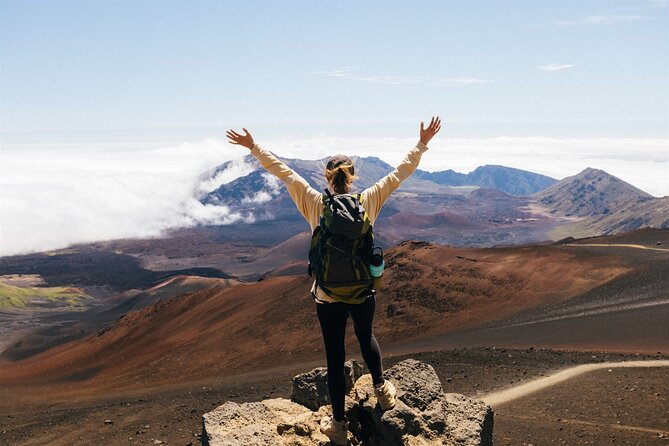Tropical hikes in Maui best waterfalls & rain forests
What’s included
- Professional local guide
- Lunch
- Nutritious snacks included
Maui hikes highlight
Hikes you don’t want to miss. moderate hike in difficulty but you will be blown away by the sheer beauty of the jungle. You’ll be amazed with the natural beauty and bamboo forest.Hike & observe the flora and fauna of interest, and we may even find some edible food!
Hiking packing list
Heading out for a day hike is a delightful way to explore nature with friends and family, or even by yourself.
These items should be on your hiking checklist:-Hiking backpack
-Weather-appropriate clothing (think moisture-wicking and layers)
-Hiking boots or shoes
-Plenty of light snacks/food
-Plenty of water
-Navigation tools such as a map and compass
-First-aid kit
-Knife or multi-tool
-Sun protection
But on this hiking packing list, you’ll also find desirable “extras,” like a camera, trekking poles, and other items that may enhance your experience.
The Makamaka’ole Falls Trail, aka 13 Crossings Trail, at the West Maui Forest Reserve in Wailuku, Hawaii is a moderate 2 mile out-and-back hike up to Makamaka’ole Falls. An additional neat feature along this trail is a dense bamboo forest that you get to hike through and a banyan tree waiting on the other side.
The hike is lightly-trafficked and you’ll hike across Makamaka’ole Stream numerous times to finally reach the waterfall, hence the 13 Crossings name. The trail is often very narrow, so you’ll brush up against plenty of wet tropical plants as you make your way through this lush jungle of a forest on your way to the falls.
This trail is rated at moderate because of the terrain and multitude of stream crossings, which are often not very easy. It’s highly recommended that you wear water shoes, water boots, or plan to get your feet soaked in order to play it safe on this trail. It’s best if you plan to hike through the creek instead of hopping from rock to rock to cross each crossing. Common sense says that when rocks are wet, they’re also very slippery – there’s no exception on this trail. I personally (Admin) got injured on this trail and had a short trip to the ER after a fall on rocks in the creek. So, with that said, trekking poles, water shoes, and patience are all recommended – plain old hiking boots may not be enough for this one.
Makamaka’ole Falls: The waterfall can be found about 0.9-miles into the hike. At mile 0.9 you’ll reach a fork in the stream – take a right-hand turn here to continue to Makamaka’ole Falls. The waterfall can be found about 0.1-miles away from the fork. Alternatively, for better and less dangerous views of Makamaka’ole Falls, you can hike the Waihee Ridge Trail and get stunning views of the upper cascades – not just the lower cascade. The view point allows you to see Makamaka’ole Falls about a quarter-mile away or so, which is just close enough to enjoy it without having to hike the creek.
Bamboo Forest: About half-way to Makamaka’ole Falls is an amazing bamboo forest with huge bamboo shoots. This is quite the sight if you’ve never hiked through a bamboo forest before, but this section of bamboo does not last for long – only a few hundred feet.
Banyan tree: Just after the bamboo forest, heading toward the falls, you’ll pass a really cool banyan tree.
Guava trees and fruit: Throughout the hike you may find guava fruit littered along the trail. These yellow or green-rind fruit have a pink inside that resembles an orange.
Flooding & Dangers: This trail lies within an area of Maui that generally gets a decent amount of rainfall. Heavy rains upstream can trigger flash floods that sweep down this creek, so watch the weather and do not hike this trail if there are heavy rains in the weather forecast. Do not attempt to cross the creek if it’s running high and the flow is strong to reduce risk of injury or drowning.
What to bring: Hikers should bring at least 1-liter of water per person. Also bring bug spray to try and ward off the mosquitoes. As stated above, proper footwear is a must-have and trekking poles should seriously be considered to help with stream crossings.
Pets: Dogs are allowed if on leash and their waste must be carried out. Please note that this trail may not be suitable for dogs regardless of the forest’s regulations. This trail can be dangerous for people and thus can be dangerous for dogs too.
Respecting the Land
Hawaiian land is considered sacred to native Hawaiians and many locals, so please stay on-trail, take nothing but photos, and leave nothing but footprints. Respect the locals – don’t stay for long and have a backup hike planned in case the parking lot is full.src
This Haleakala National Park Hike with Summit Visit allows you to follow a guide who’s super familiar with the different paths of the park.
our Haleakala Crater hike begins at the Maui Park n’ Ride. Over the course of this moderately difficult, 4-mile (6.2km) hike through the crater, the same guides will share local wisdom on the mountain’s history and ecology, and keep you safe, well fed, and informed of the mountain’s magic. This National Park has more endangered species than any other park in America and is a place that Native Hawaiians consider a sacred home to the gods. In addition to archaeological sites, visitors might encounter endangered birds such as nene geese or petrels, and walk past blooming silverswords that spring from the rocky terrain. Towards the beginning of this Haleakala Crater hike, stop to acclimate at 8,000 feet along a thin, lava-strewn trail, where you’ll also enjoy some hearty snacks with a view of the crater floor. Next, continue up towards 10,000 ft (3,048m), summit, where you’ll hike towards cinder cones bursting from the Earth with serene, multihued beauty. There’s a mystical silence up here in the crater that’s only broken by the wind, and occasionally the sound of volcanic cinder as it crunches beneath your feet. Before you’re finished hiking Haleakala, be sure to take a long look around to savor the mountain scenery, and fill up your camera with dozens of photos to help you remember the beauty. Eventually, this hiking adventure ends with a ride down the mountain and transport back to Kahului with a camera full of breathtaking photos.
Explore Maui’s Native forest and private conservation lands through the eyes of a local guide and learn about the thriving native ecosystem and watershed of Puʻu Kukui preserve. On a two mile hike beneath a canopy of shade along the valley ridgeline, you will set your eyes upon a side of Hawaii you’ve never seen before. Beyond the vivid natural beauty and vistas, you will walk away with knowledge of the island’s sacred connection to water and the importance of nature conservation.
This area is pure natural beauty and a good reason to do the full hike up here before turning back like many do.
It features wild and amazing trees and flowers from around the world along with plants, trees and shrubs that are very native to Hawaii.
Keep a lookout for the wild boar and great colourful wasps, knowing they are around certainly adds to the sense of adventure for sure.
At the top of the hike you reach the Honolua Ridge Trailhead. Once upon a time you was able to catch the shuttle bus back to the bottom but alas it does not run anymore.
But, the upside is you get to enjoy retracing the gorgeous steps you have taken to get here.

